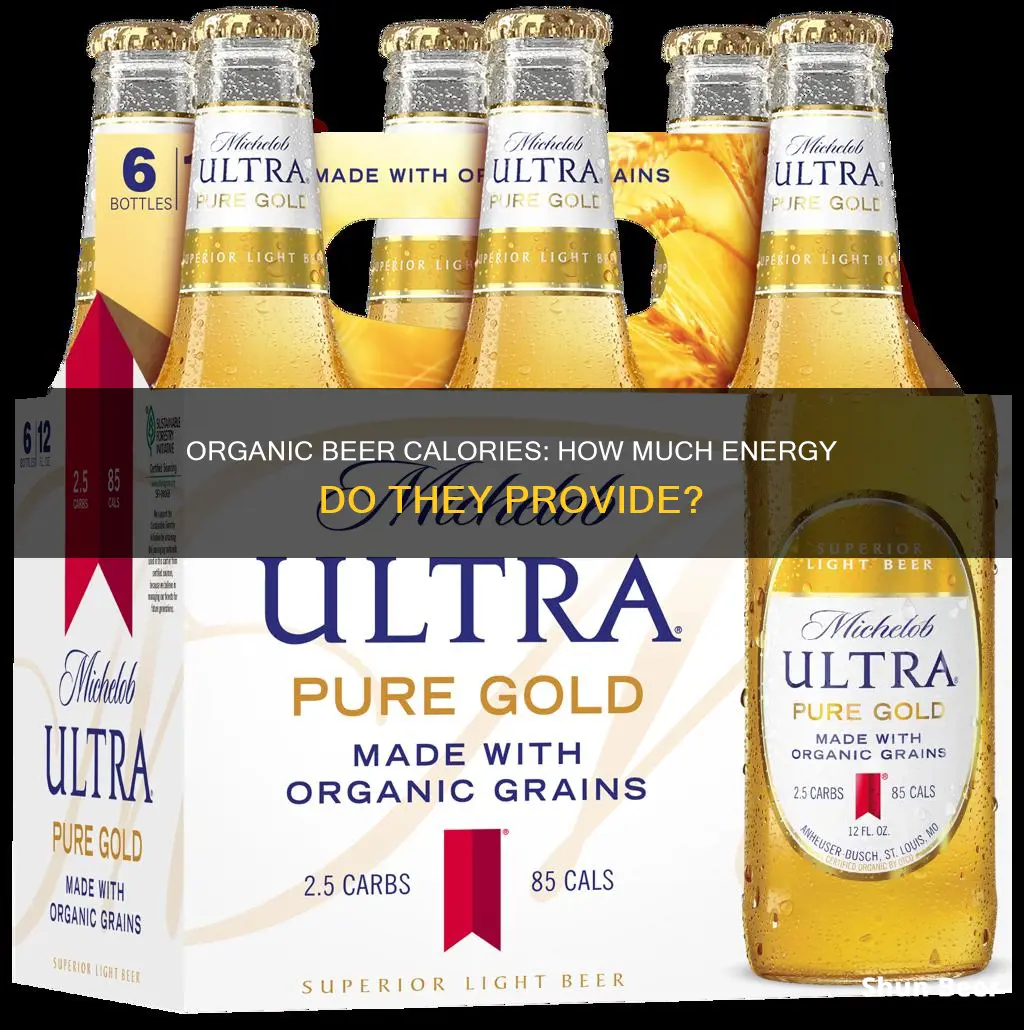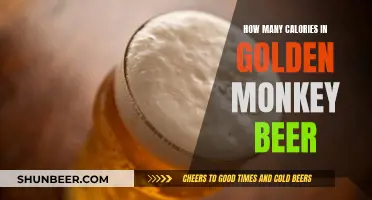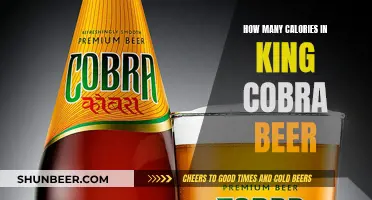
Beer is a popular drink worldwide, but it's also a source of empty calories that provide little nutritional value. The calorie content of beer varies depending on the type and maker, but it's mainly influenced by its alcohol content. A higher alcohol percentage results in more calories, and craft, seasonal, and high-alcohol beers tend to be more caloric than lighter beers. Additionally, about 60% of calories in beer come from alcohol, while 40% come from carbohydrates. So, how many calories are in organic beer?
What You'll Learn

Calorie count varies by beer and maker
The calorie count in beer varies by type of beer and maker. Beer is made from fermented grains, and the calories in beer come mainly from carbs and alcohol. The higher the alcohol content, the more calories a beer will have. The alcohol content is measured by ABV (alcohol by volume). A beer with a higher ABV will have more calories than a beer with a lower ABV.
For example, a 12-ounce lager with a 4.5% ABV will have 135 calories, while a 12-ounce barrel-aged stout with a 10.5% ABV will have 315 calories. A 12-ounce beer with a 4% ABV will have about 80 calories from alcohol, while a 5% ABV beer will have about 100 calories from alcohol.
The calorie count also depends on the pour size. A 16-ounce beer with a 6% ABV has about 240 calories. A 12-ounce serving of light beer will have 50 to 100 calories.
If you're watching your calorie intake, you can opt for alcohol-free beers, which usually have fewer calories. You can also look for low-calorie beers, which tend to have a low ABV—typically 4.5% or less.
Calories in DB Export Citrus Beer: All You Need to Know
You may want to see also

Alcohol and carbohydrates influence calorie count
The calories in beer come from two main sources: alcohol and carbohydrates. About 60% of calories in beer come from alcohol, and 40% come from carbohydrates. The more alcohol a beer contains, the more calories it will have. This is because alcohol contains more calories per gram than carbohydrates.
Alcohol
Beer is made from fermented grains, and the sugar extracted from barley and grains is what causes beer to ferment. The more sugar present, the more alcohol there will be, and therefore, the more calories. The alcohol content of a beer is measured by its ABV (alcohol by volume). A higher ABV means a higher-calorie count. For example, a 12 oz lager with a 4.5% ABV will have 135 calories, while a 12 oz barrel-aged stout with a 10.5% ABV will have 315 calories.
Carbohydrates
The amount of carbohydrates in a beer depends on how it is made. If a beer has a thicker mouthfeel, darker appearance, and sweeter flavour, it will likely have more carbs. The carbohydrates in beer are the sugars, starches, and fibres found in grains and fruit. These are an important source of energy for the body and brain. A typical 12 oz beer can have anywhere from 3g to 16g of carbohydrates.
Calorie Calculation
To estimate the number of calories in a standard beer, you can use the following calculation:
> Beer calories = ABV% x 2.5 x ounces of beer
For example, a 12 oz beer with a 5% ABV will have about 150 calories.
Calories in Vodka Diet Ginger Beer: The Ultimate Guide
You may want to see also

ABV and pour size impact calories
The calorie content of beer is influenced by two main factors: alcohol content, or ABV (alcohol by volume), and pour size. Beer is typically between 4-8% ABV, but some beers can be as strong as 14% ABV. The higher the ABV, the more calories in your beer. For example, a 12 oz lager with 4.5% ABV has 135 calories, while a 12 oz barrel-aged stout with 10.5% ABV has 315 calories.
The simplest formula to calculate the calories in a beer is: ABV% x 2.5 x ounces of beer. So, a 16 oz beer with 6% ABV has about 240 calories. A 12 oz beer with 5% ABV has about 150 calories.
The pour size also impacts the calorie content. The larger the pour, the more calories. For example, a 16 oz pour of a 9% ABV double IPA will have upwards of 350 calories.
Light beers typically have fewer calories because they have less alcohol and more water. Low-calorie beers usually have a low ABV, typically 4.5% or less, while high-calorie beers tend to have a high ABV, usually 6% or higher.
Calories in 805 Beer: Understanding the Nutritional Breakdown
You may want to see also

Calories from beer don't provide energy
The number of calories in organic beer varies depending on the beer. A 12 oz. serving can have as few as 85 calories or as many as 300 calories. A 5% ABV beer has around 100 calories from alcohol alone, while a 4% ABV beer has around 80 calories from alcohol. A lager with 4.5% ABV and 12 oz. serving will total 135 calories, while a 12 oz. barrel-aged stout with 10.5% ABV will total 315 calories.
While beer contains calories, these calories do not provide energy in the same way that calories from food do. Alcohol temporarily prevents the body from burning fat. This is because the body cannot store calories from alcohol for later use, as it does with food calories. When you consume alcohol, your metabolic system has to stop burning off calories from food to get rid of the alcohol instead. This process disrupts the equilibrium between "energy in" and "energy out," which is crucial for maintaining a healthy weight.
The calories in beer are mainly composed of carbohydrates and alcohol. The sugar extracted from barley and grains during the fermentation process leads to a higher alcohol content and, consequently, more calories. As a result, beers with higher alcohol by volume (ABV) tend to have more calories than lighter beers. Craft, seasonal, and high-alcohol beers will generally have a higher calorie count.
Additionally, beer has been described as providing "empty calories" as it offers insignificant amounts of vitamins and minerals. Alcoholic drinks are considered nutrient-poor, in contrast to food sources of calories, which provide essential nutrients along with energy. Therefore, while beer contributes calories, these calories do not translate into a substantial source of energy for the body.
To summarize, while beer contains calories, these calories do not provide energy in the same way that calories from food do. The metabolic process of breaking down alcohol disrupts the body's ability to burn fat, and beer lacks the essential nutrients found in food sources of energy. Therefore, the calories from beer do not provide meaningful energy to the body.
Calorie Counting: Bud Light Draft Beer Edition
You may want to see also

Light beers have fewer calories
The number of calories in a beer depends on several factors, including alcohol content, serving size, and carbohydrate content. Generally, the higher the ABV (alcohol by volume), the more calories a beer will contain. For example, a 12 oz lager with 4.5% ABV will have 135 calories, while a 12 oz barrel-aged stout with 10.5% ABV will have 315 calories.
Light beers, which typically have lower alcohol content, will therefore usually have fewer calories. Very low alcohol beers (2% to 3% ABV) such as Miller 64 have around 60 calories per 12 oz serving. Most light beers (around 4% ABV) have about 100 calories. Bud Light Next, for example, has 80 calories and zero carbs.
Non-alcoholic beers typically have a lower calorie content, so opting for these can be a good way to reduce calorie intake.
The serving size also affects the number of calories in a beer. A typical 12 oz beer has around 140 calories, the same as a can of Coke. However, a 16 or 20 oz draft pour of the same beer will contain 200-250 calories.
In addition to alcohol content, the carbohydrate content of a beer can also affect its calorie count. The amount of carbohydrates in a beer depends on how it is made, with darker, sweeter, and thicker beers typically having more carbs.
So, if you're watching your calorie intake, light beers are a good option as they tend to have lower alcohol content and fewer calories.
Calories in O'Doul's Beer: Nutritional Breakdown
You may want to see also
Frequently asked questions
Beer calories vary depending on the beer and the maker. A 12-ounce beer generally has about 150 calories, whereas light beer calories range from 50 to 100 calories.
The two main factors that influence the number of calories in a beer are alcohol content and carbohydrates. The higher the alcohol content, the more calories a beer will have. Similarly, beers with more carbohydrates will also tend to have more calories.
A simple formula to calculate the number of calories in a beer is ABV% x 2.5 x ounces of beer. For example, a 16-ounce beer with 6% ABV has about 240 calories.
Yes, there are several low-calorie or light beers available. Some popular options include Bud Light, Coors Light, Yuengling Light Lager, Amstel Light, and Michelob Ultra. These beers typically have fewer than 100 calories per can or bottle.
Beer tends to contain more calories than wine or spirits like whiskey. A shot of whiskey will typically have more calories than a shot of beer due to its higher alcohol content. However, wine tends to have a higher ABV than beer, so it generally has more calories per serving.







